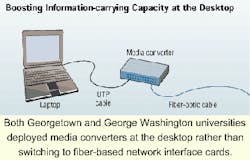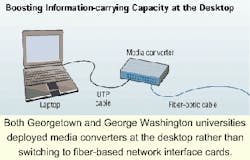The products' cost-effectiveness and the flexibility they give users make them a here-and-now choice.
It's been well-documented that fiber-optic cable in horizontal applications provides users with substantial information-carrying capacity. Even though Gigabit Ethernet trials showed that not all multimode fiber is equally capable, any multimode fiber in the horizontal provides a significant throughput advantage over unshielded twisted-pair (UTP) cable.
"If you want to run Gigabit Ethernet over any distance, you realistically need a fiber-optic infrastructure," says James Mustarde, director of marketing communications with networking-equipment maker Allied Telesyn (www.alliedtelesyn.com). "And if you're planning to take a gigabit-speed link a reasonable distance, you will need singlemode fiber."
Another well-documented fact about fiber in the horizontal is that the cost of fiber-based networking electronics is the single biggest hurdle for many potential users. While costs of the passive optical infrastructure have come down to a point where some fiber-to-the-desk systems are economically comparable to UTP systems, optical networking gear still is far more costly than copper-based equipment.
"There is a lot of legacy copper-based equipment in place," says Juan Pulido, product market manager for active equipment with 3M Telecom Systems Division (www.mmm.com/telecoms). "That equipment is likely to stay in place for some time," he adds. "It is equipment that the owners have become comfortable with."
Media conversion steps in
So, many users are in a position of trying to protect their investments in copper-based local area network (LAN) electronics while their network traffic increases, making a fiber system's information-carrying capacity more attractive than ever. "Given the ongoing transition to faster technologies, deployment of these technologies is outpacing the upgrade of cabling infrastructures," says Mustarde.
In these circumstances, the deployment of media converters has proven to be an appropriate solution for several users. "The intent of media converters is to convert copper systems to fiber," says Pulido. "There are other uses, but the copper-to-fiber conversion is the main focus. The media converter can be viewed as a temporary solution that allows users to put in place a fiber interface."
"Mainly, media conversion is needed because the majority of NICs [network interface cards] are copper-based," according to Dave Szczepanik, product manager with Sun Conversion Technologies (www.sunconversion.com). "Until more fiber NICs begin appearing in computers, media converters will be necessary."
Pulido works within 3M's Volition operation. Volition is available as an end-to-end fiber system, but it also includes media converters to address legacy equipment. He says that in these situations, "You can employ the physical infrastructure now. Then you do not have to change all your electronics at the same time. You can methodically replace copper-based equipment with fiber-based, but begin using fiber in the horizontal right away."
Legacy equipment makers report that media conversion is indeeed a cost-effective approach. "Certain types of converters are available for $160 to $180 apiece," notes Allied Telesyn's Mustarde.
Some LAN administrators tend to agree, too. "Many NICs are overpriced," says Rich Kogut of Georgetown University, which installed and continues to install media converters across its campus. "I can buy media converters for less than the cost of NICs," he says.
Conversions at Georgetown
Georgetown has approximately 2,000 fiber-to-the-desk drops in its residence halls. The university is overhauling much of its Category 3 infrastructure with fiber. "We are currently on a shared 10Base-T system," Kogut says. "With our upgrade, we are going to switched 10/100-Mbit/sec for those who need it."
Sun Conversion Technologies has been the media-converter supplier for the Georgetown upgrade, and Szczepanik reports, "Georgetown has had a fiber-optic backbone since the 1980s. The hurdle to more fiber, financially, has been the cost of the electronics. The product that Georgetown has used is our Model 110C. That product is unique in that it is 'unplugged'-it does not require an AC outlet."
Kogut explains, "We are using the converters on the desktop side, for a couple of reasons. We don't want to swap out the NICs that are in place. Laptop computers are places where you want to use RJ-45 connections. The price comparison between NICs and media converters is also a factor."
He adds that media conversion, and fiber-optic deployment in general, are good choices for the campus. "There are many reasons you may want to take steps like this. For us, it has a lot to do with older buildings that have small wiring closets. If we were to upgrade from Category 3 to Category 5-plus, we would need more room-partially because of spacing out the UTP cables to avoid crosstalk. As speeds get higher and higher, not only does the cost of UTP cabling go up, but the space requirements for it increase as well."
Kogut says that "Using a single electronics room is advantageous, and we are able to do that with a fiber infrastructure. In fact, there is no place we could even put a wiring closet in many of the buildings."
GWU's novel approach
George Washington University, meanwhile, employed media converters to achieve several optical-networking efficiencies. Like Georgetown, George Washington University (GWU) set up media converters at the desktop. "Each student was provided with a media converter for connection to a laptop," says 3M's Pulido. "In the past, this type of use would not be economically feasible." He equates media converters to "electronic optical patch cords" when they are used in this manner. "They are like patch cords in that you can move them to different places in the system."
Another novel use of media converters at George Washington took place inside the telecommunications room. Essentially, converters were used in place of a switch. "In a traditional distributed design with a switch, there is a 1-Gbit uplink. The bottleneck is the switch," Pulido says. GWU's approach was to terminate each horizontal copper cable to a media converter, connecting it directly to the fiber backbone. The backbone then connected to a switch in the data center.
Pulido says that media converters' general functions apply to many situations and can help solve several cabling challenges, all over the world. He points to an Italian application as an example. "In Milan, they are used in multitenant buildings, where broadband services are brought through the headend and to the customer. Because of contractual obligations, the user employs copper-based equipment. The media converters facilitate a copper-based IP gateway." Likewise, he says, in the Nordic region of Europe there is widespread desire for fiber-to-the-home for high-speed Internet access.
Here to stay?
Pulido and Allied Telesyn's Mustarde both note that media converters largely are unmanaged, representing something of a blind spot in a network. "That is why they are sometimes not used even when they are a viable option," Pulido says.
"In recent years, there has been a growing demand for managed converter systems," Mustarde notes. "It is not a huge market currently, but it is an option for people who want it. Managed conversion systems use SNMP with a graphical user interface."
He says demand for high-density conversion systems also is increasing. "We are seeing demand for 18- to 24-blade-capable systems in a 19-inch rack," he says. "Blade systems will also grow in popularity."
Pulido is not as convinced, however, that the market for media converters will grow steadily. "The media converter itself may come to an end," he says. He notes that NIC costs are coming down, to a point at which they are approaching parity with media converters. So, if the use of media converters no longer provides a cost advantage over swapping NICs in applications like Georgetown and George Washington, users may choose to replace the NIC.
But Mustarde makes a case for the technology's long-term viability. "Media converters represent a real benefit for businesses seeking cable length that can only be achieved through converters."
Given the economic impact to an end-user organization of eliminating all copper-based networking equipment and replacing it with fiber-based equipment, there remains a solid likelihood that many who move to fiber will use media converters as a transition tool.
Editor's note: For more information on the fiber-optic cabling system at George Washington University, see "You're never too old to collapse your backbone," (March 2001, page 43).
Patrick McLaughlin is Chief Editor of Cabling Installation & Maintenance.

